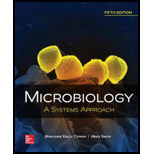
Concept explainers
The primary B-cell receptor is
- a. IgD.
- b. IgA.
- c. IgE.
- d. IgG.
Introduction:
Immunoglobulins are the glycoprotein molecules which are present in a Y shaped structure. They bind to the antigenic foreign epitopes and inhibit the spread of infection inside the human body. They are composed of one heavy chain and one light chain with variable and constant regions in the polypeptide protein.
Answer to Problem 1MCQ
Correct answer:
The primary B-cell receptor is IgD. Therefore, option (a) is correct.
Option (a) is given as “IgD”.
Explanation of Solution
Justify reason for the correct statement:
In the case of B lymphocytes, the genes code for Ig (immunoglobulins) synthesis, which are the receptors for B-cells. There are antigen binding sites in the ends of forks that are formed by the heavy and light chains and are variable in shape with respect to the shape of antigens. IgDis one of the classes of Igs that is secreted in blood and is present as a part of the membrane surface receptor molecule on
Hence, option (a) is correct.
Justify reasons for the incorrect statements:
Option (b) is given as “IgA”.
IgA is secreted in the lactating milk and forms the defense immunity in a child. It is not the primary Ig of B-cell receptors. Hence, it is a wrong answer.
Option (c) is given as “IgE”.
IgE is released from the mast cells following an antigenic response in the human body. It is not the primary Ig of B-cell receptors. Hence, it is a wrong answer.
Option (d) is given as “IgG”.
IgG is the antibody which is formed from activated
Hence, options (b),(c), and(d) are incorrect.
IgD is the immunoglobulin class that is considered as the primaryreceptor of B-cell.
Want to see more full solutions like this?
Chapter 15 Solutions
Microbiology: A Systems Approach
- Describe the principle of homeostasis.arrow_forwardExplain how the hormones of the glands listed below travel around the body to target organs and tissues : Pituitary gland Hypothalamus Thyroid Parathyroid Adrenal Pineal Pancreas(islets of langerhans) Gonads (testes and ovaries) Placentaarrow_forwardWhat are the functions of the hormones produced in the glands listed below: Pituitary gland Hypothalamus Thyroid Parathyroid Adrenal Pineal Pancreas(islets of langerhans) Gonads (testes and ovaries) Placentaarrow_forward
- Describe the hormones produced in the glands listed below: Pituitary gland Hypothalamus Thyroid Parathyroid Adrenal Pineal Pancreas(islets of langerhans) Gonads (testes and ovaries) Placentaarrow_forwardPlease help me calculate drug dosage from the following information: Patient weight: 35 pounds, so 15.9 kilograms (got this by dividing 35 pounds by 2.2 kilograms) Drug dose: 0.05mg/kg Drug concentration: 2mg/mLarrow_forwardA 25-year-old woman presents to the emergency department with a 2-day history of fever, chills, severe headache, and confusion. She recently returned from a trip to sub-Saharan Africa, where she did not take malaria prophylaxis. On examination, she is febrile (39.8°C/103.6°F) and hypotensive. Laboratory studies reveal hemoglobin of 8.0 g/dL, platelet count of 50,000/μL, and evidence of hemoglobinuria. A peripheral blood smear shows ring forms and banana-shaped gametocytes. Which of the following Plasmodium species is most likely responsible for her severe symptoms? A. Plasmodium vivax B. Plasmodium ovale C. Plasmodium malariae D. Plasmodium falciparumarrow_forward
- please fill in missing parts , thank youarrow_forwardplease draw in the answers, thank youarrow_forwarda. On this first grid, assume that the DNA and RNA templates are read left to right. DNA DNA mRNA codon tRNA anticodon polypeptide _strand strand C с A T G A U G C A TRP b. Now do this AGAIN assuming that the DNA and RNA templates are read right to left. DNA DNA strand strand C mRNA codon tRNA anticodon polypeptide 0 A T G A U G с A TRParrow_forward

 Concepts of BiologyBiologyISBN:9781938168116Author:Samantha Fowler, Rebecca Roush, James WisePublisher:OpenStax College
Concepts of BiologyBiologyISBN:9781938168116Author:Samantha Fowler, Rebecca Roush, James WisePublisher:OpenStax College Medical Terminology for Health Professions, Spira...Health & NutritionISBN:9781305634350Author:Ann Ehrlich, Carol L. Schroeder, Laura Ehrlich, Katrina A. SchroederPublisher:Cengage Learning
Medical Terminology for Health Professions, Spira...Health & NutritionISBN:9781305634350Author:Ann Ehrlich, Carol L. Schroeder, Laura Ehrlich, Katrina A. SchroederPublisher:Cengage Learning





